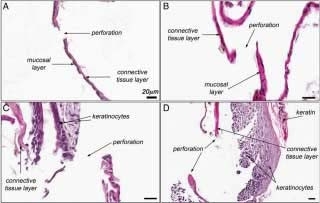Regenerative treatment
We are proud to announce that after our initial discovery was made in 2013 and following a license to Astellas Pharmaceuticals, this treatment was approved as an Investigational New Drug by the FDA and entered clinical trials in 2020.
The tympanic membrane is unique in that it is a trilaminar structure suspended in air composed of an inner mucosal layer, middle fibrous connective tissue layer and an outer keratinocyte layer. There is a constant production and migration of keratinocytes outward from progenitor cell areas at the umbo. When activated by injury this process accelerates and, unlike cutaneous healing where the keratinocytes move over a wound bed, the tympanic membrane heals over air as the keratinocytes form the leading edge until the perforation is closed macroscopically. Wound remodelling then occurs. This process sometimes does not occur and a chronic inflammatory phase is entered creating a chronic perforation.
HB-EGF is from the EGF family of growth factors. EGF family members can induce juxtacrine, autocrine, paracrine, or endocrine signaling depending on the cellular environment because they are cleaved from the membrane by metalloproteinases to form the mature soluble growth factor. Unlike EGF, HB-EGF binds to both HER1 and HER4. The metalloproteinases (including ADAM 9, 10, 12, 17) responsible for ectodomain shedding of pro HB-EGF predominantly regulate the binding of mature HB-EGF and regulate activation of EGFRs. HB-EGF then acts through both EGFR-dependent and EGFR-independent mechanisms. Our results show that HBEGF can induce keratinocyte migration in a chronic TM perforation to close the perforation and create a histologically comparable healed TM.
We have collaborated with the Yang lab at Stanford who has developed a novel hydrogel delivery system. Our further translational work has been to optimise the dose and show non toxicity.
1.Santa Maria PL, Varsak KY, Kim S, Yang YP. Heparin Binding – Epidermal Growth Factor Like Growth Factor for Regeneration of Chronic Tympanic Membrane Perforations in Mice. Tissue Eng Part A. 2015;21(9-10):1483-94.
2.Santa Maria PL, Gottlieb P, Santa Maria C, Kim S, Puria S, Yang YP. Functional Outcomes of Heparin-Binding Epidermal Growth Factor-Like Growth Factor for Regeneration of Chronic Tympanic Membrane Perforations in Mice. Tissue Eng Part A. 2017;23(9-10):436-

Inhibition
Maintaining a chronic perforation in a tympanic membrane (TM) is part of the current standard of care for a number of middle ear diseases, including primary Eustachian tube dysfunction, otitis media with effusion, and recurrent acute otitis media. Having a physical structure, a pressure equalization tube (PET), placed within TM is the only clinically available method for inhibiting TM regeneration and maintaining an opening. The presence of PET is associated with a number of problems, including tube associated otorrhea, linked to biofilm formation on the tube, medial migration of the tube, tube retention, induction of granulation tissue, and a small but significant rate of cholesteatoma.
KB-R7785 [4-(N-hydroxyamino)-2R-isobutyl-3S-methylsuccinyl)-L-phenylglycine-N-methylamide] is a matrix metalloproteinase (MMP) inhibitor with a particular inhibitory action on MMP-2, MMP-9, disintegrin, and metalloproteinase domain-containing protein 12 (ADAM12). KB-R7785 administration is thought to inhibit TM wound healing via the inhibition of heparin-binding epidermal growth factor-like growth factor (HB-EGF)-mediated epidermal growth factor receptor (EGF-R) ectodomain ligand shedding. This migration and proliferation of keratinocytes from progenitor cells located at the attachment of TM to the malleus handle play a crucial role in TM wound healing. Given this timing of chronic perforation, this treatment has the potential to replace the physical obstruction method of PETs if further developed into a suitable structure that allows ventilation in the early period.
Santa Maria, Peter Luke, Chloe Santa Maria, Sungwoo Kim, and Yunzhi Peter Yang. “Single Administration of a Sustained-Release Formulation of KB-R7785 Inhibits Tympanic Membrane Regeneration in an Animal Model.” The Journal of International Advanced Otology 12, no. 3 (December 2016): 237–40. https://doi.org/10.5152/iao.2016.3124.

Principal Investigator
Lead Research Scientist
